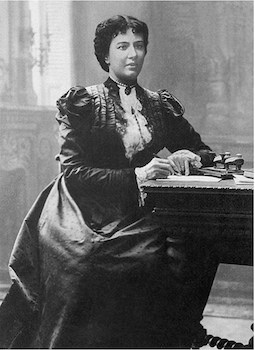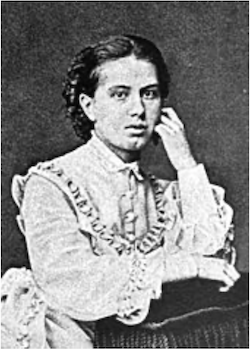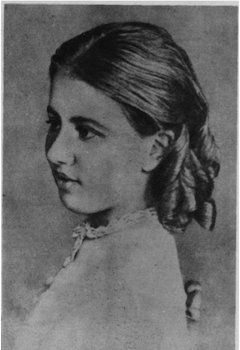
Sofya Vasilyevna Kovalevskaya was born on January 15, 1850, in Moscow, Russia. She grew up in privileged surroundings because her Russian family claimed minor nobility. As the middle child in her family, placed between her well-behaved and admired older sister Anya, and her younger brother Fedya who would become heir to the family, Kovealevskaya was neglected and pushed to become a proper young lady within society by her governess.
Kovalevskaya’s exposure and subsequent interest in mathematics occurred after she discovered lecture notes from a calculus class her father had taken. This interest in mathematics was further amplified through her uncle who would openly and intently discuss mathematical concepts with her. Therefore, Kovalevskaya studied mathematics against her father’s wishes, smuggling textbooks into her room so that she could learn more. When she was 14 years old, she taught herself trigonometry so that she would be able to understand a physics book her neighbor had lent her. The neighbor, who was also the book's author, was deeply impressed by her resilience and capabilities. So, the neighbor went to Kovalevskaya’s father and convinced him to let her go to school, so she could pursue her studies in St. Petersburg.
After finishing her secondary schooling in St. Petersburg, Kovalevskaya was determined to continue pushing forward her education at the university. However, at the time, the Russian university system was closed to women. The only available path to study at university was for Kovalevskaya to go to Switzerland. Still, her father would not let her go because according to his rules, young and unmarried women were not allowed to travel abroad. To overcome this hindrance from her education, she entered a marriage of convenience in 1868 with 26-year-old university student, Vladimir Kovalevsky. The newlyweds remained in St. Petersburg for a short amount of time and then moved to Heidelberg, Germany where they would be able to pursue higher education.

In 1870, Kovalevskaya moved to Berlin after completing her degree in physics, where she would be studying under the tutelage of Karl Weierstrass at the University of Berlin. During this time, Weierstrass was one of the most renowned mathematicians of his time and when Kovalevskaya approached him, he did not take her seriously because of her gender. Only after evaluating a problem set that he had given her, Weierstrass realized that she had immense talent and was a budding genius. He immediately decided that he would tutor her privately since the university would not permit any women to attend as a student. Kovalevskaya studied under him for four years, and she was quoted saying, "These studies had the deepest possible influence on my entire career in mathematics. They determined finally and irrevocably the direction I was to follow in my later scientific work: all my work has been done precisely in the spirit of Weierstrass". Throughout her teachings with Weierstrass, Kovalevskaya produced three bodies of research, hoping that one of them would be selected by the university potentially allowing her to earn a degree. She was given the honor of having her first body of work, “On the Theory of Partial Differential Equations,” published in Crelle’s journal: a German mathematics journal founded by Niels Henrik Abel. The publication took Kovalevskaya from being a relatively unknown mathematician to receiving attention for her work.
Kovalevskaya’s achievements only grew from there. In 1874, she was granted a PhD from the University of Gottingen. However, even with her degrees and the help of Weierstrass, she was not able to find employment. During this time she experienced immense loss with the passing of her father. Nevertheless, Kovalevskaya and Vladimir comforted each other during the challenging times and had a daughter named Sofia who was born in 1878. During this time, Kovalevskay decided to head in a different direction by pursuing the literary arts and cultivate her talent in other fields, trying her hand at fiction, theater reviews, and science articles for a newspaper.
Kovalevskaya eventually returned to mathematics in 1880 with a newfound opportunity–there was prospect of finding employment in her favored field. Kovalevskaya moved back to Berlin and it was not very long before she found out about the death of her husband Vladimir. Kovalevskaya’s grief led her to immerse herself in her work.

Kovalevskaya’s circumstances improved in 1883 when she was allowed to be a lecturer at the University of Stockholm. It was only a temporary position, but by the end of her five years at the university, she had more than proven her skills and worth to the university who rewarded her. Her accomplishments only continued after this: the university granted her a tenured position as an editor for a famed mathematics journal. In 1885, Kovalevskaya was appointed the position of chair of mechanics for the university.
Kovalevskaya continued to struggle with heartbreak as her sister passed away in 1887. However, she soon experienced one of the greatest achievements of her life. In 1888, she won the Prix Bordin from the French Academy of Science, a prestigious honor awarded to works treating to the public interest, to the wellbeing of society, to the progress of science and more, because of her work "On the Rotation of a Solid Body about a Fixed Point,” In her paper, Sofia developed the theory for an asymmetrical body where the center of its mass is not on an axis in the body. On February 10, 1891, Kovalevskaya died due to complications with pneumonia and depression. The scientific world mourned her loss.
Kovalevskaya published ten papers in mathematics, mathematical physics, and several literary works. Many of these scientific papers/research articles were ground-breaking theories or the impetus for future discoveries. She is best known for paving the way for women in the scientific world, rising against everything and pursuing her dreams of being a mathematician despite the pushback she received. Kovalevskaya will forever be known for her resilience and groundbreaking discoveries that paved the way for future research.
Why Did I Choose to Research Sofya Vasilyevna Kovalevskaya?
Sofya Kovalevskaya faced sexism, resistance, and pushback throughout her education and career as a mathematician, but she never took that into account and kept pushing towards her dreams and aspirations. She not only opened the doors for other women in mathematics and STEM but accomplished her own dreams of discovering new possibilities and achievements within the field of mathematics. She is a reminder that anything is possible, as long as you persevere.
Works Cited
Britannica.com. Sofya Vasilyevna Kovalevskaya (March 20, 2024). Retrieved from https://www.britannica.com/biography/Sofya-Vasilyevna-Kovalevskaya
Agnesscott.org. Sofya Kovalevskaya (April, 1995). Retrieved from https://mathwomen.agnesscott.org/women/kova.htm
Rappaport, Karen D. (1981) S. Kovalevskaya: A Mathematical Lesson. p.564-573 Retrieved from https://www.google.com/books/edition/Who_Gave_You_the_Epsilon/WwFMjsym9JwC?q=karen+rappaport+%22a+mathematical+lesson%22&gbpv=1#f=false
Medium.com. Sofya Kovalevskaya (October 16, 2020). Retrieved from https://medium.com/sci-illustrate-stories/sofia-kovalevskaya-a6af455eeac7
This article was published on 9/20/24